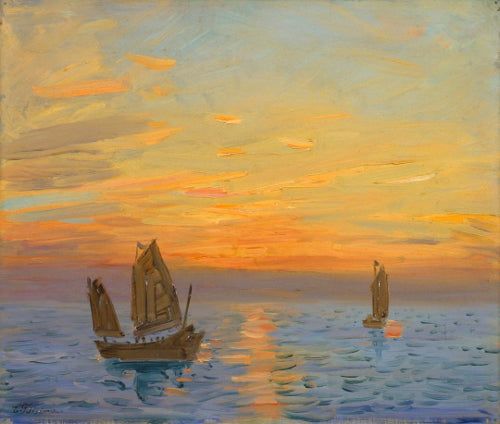Description
The painting "Dawn (The Sea)" by Fujishima Takeji is a splendid example of the Nihonga style, which fuses traditional Japanese techniques with a modernist sensibility. This work, executed in 1910, presents a poetic and serene vision of the sea, capturing a precise temporal moment that awakens a sense of calm and beauty. The piece is imbued with the ethereal atmosphere that characterizes much of the Japanese landscape, offering a visual interpretation at dawn that goes beyond mere representation.
At first glance, the composition of "Dawn (The Sea)" stands out for its balance and its masterful use of color. The horizon appears as a thin line where the sky meets the water, a point of convergence that evokes a feeling of infinite expansion. The warm tones of dawn, ranging from oranges to golds, beautifully contrast with the deeper blues of the ocean, creating an environment that transitions from the darkness of night to the brightness of day. This use of color not only describes a landscape but also suggests an emotional state, inviting the viewer to an intimate reflection on the cycle of life and nature.
One of the most fascinating aspects of the work is the way Fujishima integrates elements of Japanese culture. The representation of the waves and the sea is not merely a visual fact but refers to the aesthetic and spiritual history of Japan, where water symbolizes both life and transcendence. The almost pictorial quality of the enchanted sea is an invitation to contemplate the relationship of humanity with nature, a recurring theme in Japanese art and in Fujishima's approach to his works.
As for the characters, this painting presents itself as a landscape without the direct presence of human figures, capturing a moment of solitude and, at the same time, connection with the environment. The absence of humanity in the image does not detract from the piece; on the contrary, it intensifies the feeling of serenity and introspection. The viewer is guided to become part of the landscape, to immerse themselves in the calm and ephemeral beauty of dawn.
Fujishima Takeji, a renowned artist in the Nihonga movement, dedicated himself to creating works that, while traditional, overflowed with contemporary energy. Drawing elements from Western Impressionism, his work, including "Dawn (The Sea)," reflects a deep interest in light and its effect on the environment. His techniques of pigment application, often in layers, achieved a subtle glow that resonates with the expected luminosity of a dawn.
In this sense, similar works by other Nihonga artists or even by Impressionists can provide a greater understanding of Fujishima's position within art history. However, his ability to evoke the Japanese landscape through a unique approach makes "Dawn (The Sea)" a singular piece that continues to resonate with contemporary viewers and art admirers, providing a visual refuge in an often tumultuous world.
In conclusion, "Dawn (The Sea)" is not just a representation of the marine landscape, but a meditation on light, nature, and the human experience. Through a carefully considered palette and an essentially Japanese technique, Fujishima Takeji captures a moment of sublime beauty that invites contemplation and emotional connection. The work is a tribute to nature and a testament to the deep artistic traditions of Japan, a bridge between the past and the present discovered in every glance.
KUADROS ©, a famous painting on your wall.
Hand-made oil painting reproductions, with the quality of professional artists and the distinctive seal of KUADROS ©.
Reproduction service of paintings with a satisfaction guarantee. If you are not completely satisfied with the replica of your painting, we will refund 100% of your money.

